In today’s fast-paced business world, efficient time tracking is one of the scaffoldings upon which successful enterprises are built. The right work hours tracker does more than just record the tick-tock of the daily grind – it transforms the abstract concept of time into tangible data, driving productivity and profitability.
As you stand at the crossroads of choosing the best tool for this pivotal task, this article will guide you through a curated selection of top-tier work hours trackers and impart valuable tips to ensure that your choice not only matches your business needs but also amplifies your team’s potential to thrive.
Without further ado, let’s dive right in!
- What Is a Work Hour Tracker?
- Main Benefits of Work Hours Trackers
- Primary Types of Work Hours Trackers
- Must-Have Features in a Perfect Work Hours Tracker
- What to Consider When Choosing a Work Hour Tracker
- Why Employees May Resist to Record Work Hours
- How to Motivate Your Team to Use a Work Hour Tracker
- 10 Best Work Hour Trackers to Choose from
- Conclusion
Understanding the Purpose of Work Hours Trackers
A work hours tracker is akin to the ever-vigilant sentinel of the professional world, standing guard over the precious currency of time. This nifty tool diligently logs the hours spent on various tasks, transforming the abstract concept of the workday into concrete, actionable data.
With a work hours tracker, you can dissect and analyze your time investments, optimizing productivity and separating wheat from chaff in your daily routines. It eliminates guesswork and approximations from your understanding of resource utilization, reveals inefficiencies, and prompts how to achieve time management excellence.
Take Control of Your Day: Main Benefits of Work Hours Trackers
- Improved time management: A work hours tracker helps pinpoint how you spend time, uncovering patterns that might contribute to inefficiency. By monitoring the hours dedicated to specific tasks, you can better allocate your time, prioritize tasks, and meet deadlines more consistently.
- Increased productivity: When employees know that their time is being tracked, they tend to focus on work better and avoid procrastination and distractions. Overall, a work hours tracker serves as a catalyst for productivity, nudging employees towards a more disciplined approach to their tasks.
- Enhanced work balance: By keeping a record of time spent on work, you can easily detect overtime, avoid the pitfalls of overworking, and enjoy a better work-life balance in the end. It helps you make sure that work does not encroach upon your personal time, which is vital for long-term career satisfaction and mental well-being.
- Accurate billing and payroll: A work hours tracker promotes accurate invoicing, which is essential for jobs that bill by the hour, or for freelance work. It also assists in streamlining payroll processes and fosters better compliance with labor laws.
- Data-driven decision-making: Work hour trackers provide invaluable data that aid managers in making informed decisions regarding staffing, resource allocation, and workload distribution. This data-driven approach promotes more effective project management and a healthier work environment.
Primary Types of Work Hours Trackers
1. Manual-entry timesheets
Weekly timesheets are the time-tested method where employees record work hours spent on different projects and tasks daily by hand, using either spreadsheets or specialized online tools. This method relies heavily on individual responsibility and memory, and while it offers simplicity, it’s susceptible to human error and can be time-consuming to manage and audit.
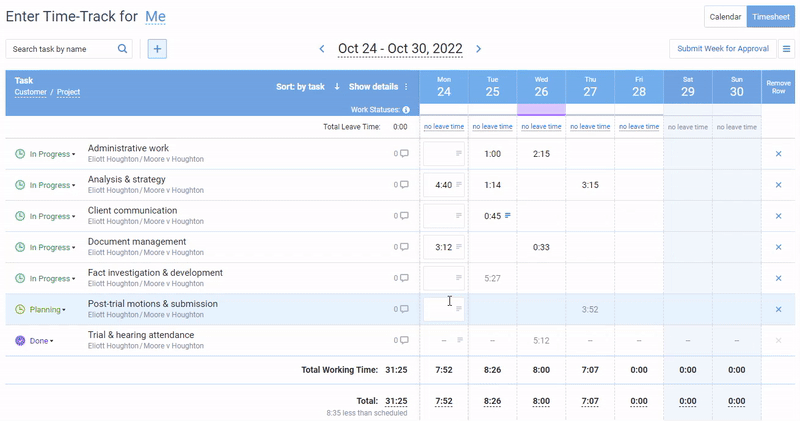
Easily switch between the traditional weekly timesheets to intuitive calendars and record work hours in the most convenient way with actiTIME.
2. Apps with one-click timers
This type of software enables employees to track their work hours with a simple start and stop button on their devices. User-friendly and convenient, partly automated hour tracking apps often include additional features like basic task planning and resource allocation, which makes them a popular choice for undemanding project-based teams or freelancers and consultants who hanker better work organization.

Enjoy the ease of partly automated work hour tracking with actiTIME Mobile – highly precise productivity data is just one screen tap away.
3. Fully automated hour trackers
These cutting-edge time management tools record work hours and fill out timesheets without direct user interaction. They’re designed to reduce the administrative burden, increase accuracy, and provide detailed insights into how employees spend their time on different websites and apps and often use sophisticated algorithms to distinguish between work and leisure activities.

Forget about the hassles of manual hour tracking with Time Management Assistant. Select which websites you want it to track and focus on tasks at hand – the extension will record every second you spend online 100% automatically.
4. Time clock apps
This type of tools represents the digital evolution of the traditional punch clock. They allow employees to clock in and out using their smartphones or designated terminals. Advanced versions include features like GPS verification, biometric security measures, and integration with payroll systems, greatly reducing the risk of time theft and buddy punching while streamlining the entire wage management cycle.
Must-Have Features in a Perfect Work Hour Tracker
- Simple interface: The cornerstone of any user-friendly hour tracker is its simplicity. It allows users to navigate and operate the software with minimal instruction, thereby reducing the learning curve and ensuring quick adoption across teams.
- Diversity of time tracking methods: A top-tier tracker offers various ways to record work hours, catering to different user preferences – whether it’s manual data entry, automatic productivity tracking, or using a timer.
- Flexible settings: Every business and workplace is unique. That’s why a work hour tracker should offer users an opportunity to tailor its settings to the specific team and project requirements.
- Billable vs. non-billable hours: Distinguishing between billable and non-billable hours promotes accurate invoicing and helps teams understand where their time is most profitably spent.
- Performance reports: Visual charts and detailed reports let users analyze the way they utilize resources and see how efficient their work is. Accurate performance data helps to enhance productivity, guiding future decisions and strategies in the right direction.
- Work allocation: Even the most basic work planning functionality assists in distributing tasks evenly and transparently across your team. It helps maintain an optimal workload balance and prevent burnout among employees.
- Time off management: Productivity is not just about one’s work time but their time off as well. By empowering you to manage employees’ absences and working hours within the same platform, a work hour tracker can greatly improve your resource management outcomes.
- Automated invoicing: A work hour tracker should help you to create error-free and professional-looking invoices in a snap, enabling you to receive due payments from clients faster.
- Built-in notifications: A perfect tracker will automatically remind your team to fill out timesheets every day and keep you in the know when a deadline is approaching or a risk of budget overrun appears.
- Cost tracking: Having the option to set pay rates for employees, you can track staff-related costs along with the time invested in projects. Monitoring project expenses against the set budget can prevent overspending and maintain financial control.
- Multiple integrations: A work hour tracker must be easy to mesh with other tools used within your organization. This is crucial for a smooth workflow and a rapid exchange of data across the platforms of choice.

As an intuitive multifunctional work hour tracker, actiTIME boasts all of the above features and traits to provide you with a seamless and truly convenient time tracking experience and help to enhance your performance outcomes multifold.
What to Consider When Choosing a Work Hour Tracker
Team type
-
Do you manage an international company with facilities in several distant countries?
The time zone management feature, which some of the time tracking products include, will be very useful for you. It will give you an accurate picture of local time in each of your offices, aid in arranging meetings and negotiations with international team members, and save you a ton of time and energy by making all this as simple as ever.
-
Would you like to impose a certain level of control over employees who work from home?
You may appreciate the clock-in and clock-out features that many time tracking apps have. With its help, you’ll be able to see when (and even where) your subordinates start and end their workdays and, thus, will worry whether they spend time doing their jobs at least a bit less.
-
Is it critical for your employees to be able to track time on the go, from different devices and through various platforms?
When employees are regionally distributed and utilize highly diverse devices to perform tasks, product compatibility may become a problem. Therefore, you should make sure that the work hour tracker you assume to buy can be installed on and accessed through multiple types of technology.
Workflows
-
Are your employees required to make daily progress reports, attend regular meetings, and discuss matters several times a day?
If yes, an excellent option for you would be a time tracking product that incorporates such additional features as notifications to remind everyone of upcoming meetings and soon-to-due tasks and a messenger to foster nonstop information sharing.
-
Do you interact with your customers throughout the project’s life cycle and perform precise calculations to charge them per each billable second of your specialists?
In this case, you will do well out of a time tracking tool that supports automated billing per hours tracked and integration with external apps you normally use when communicating with customers.
Leadership style
-
Are you focused on operational and informational transparency, and do you aim to include every employee in the decision-making process as a democratic leader would?
If the answer is yes, a work hour tracking app enabling users to access their colleagues’ time tracking data and send messages and notes to each other will be perfect for you.
-
Are you an autocratic leader who prefers making decisions independently, finds comfort in controlling each detail, and expects faultless compliance with rules from your employees?
Then, consider buying a work hours tracker that will let you configure permissions and restrict data visibility for different users. It would be even better for autocratic leaders if apps of their choice had real-time clock-in features and advanced user notification systems.
-
Do you like to plan everything in advance and utilize evidence to support various decisions as a strategic leader would?
The ability to create future-oriented employee schedules and conduct detailed analyses based on time tracking data would be of tremendous help.
Teamwork style
-
Do your employees prefer to perform tasks in close collaboration with each other?
In this case, choose a tool that provides users with space to communicate online in real time and with access to data on each others’ work progress.
-
Do your employees prefer to perform tasks in close collaboration with each other?
In this case, choose a tool that provides users with space to communicate online in real time and with access to data on each others’ work progress.
-
Do you let employees choose when they want to work and swap shifts with each other?
Then, an app with a shift bid feature will be of extra worth for your team and will facilitate the interactive scheduling process considerably.
-
Does your team adhere to the Agile Manifesto principles and aim to create a highly interactive and responsive workplace environment?
You will benefit from combining the time tracking functionality with Kanban and similar systems for feasible and adaptive project management since they foster flexible task management, quick creation and editing of tasks, and a visually appealing overview of project progress and status change.
Team size
-
Do you have a medium-sized business and does your team consist of about a hundred employees?
In this situation, a high-quality solution may cost you a lot since many companies selling work hour trackers charge monthly fees per user. Still, you could look for time trackers whose pricing depends on the variety of features included rather than on the number of users. Luckily for you, some options (even the free ones) that afford an unlimited number of users do exist.
-
Do you want to align tool configurations and settings with specific policies adopted in your company and increase the convenience of software utilization for different departments and employees?
If so, customization of settings is an indispensable app attribute for you since it is crucial for switching off unnecessary tool functions; tailoring timesheets, corporate calendars, and various reports to specific organizational needs; and managing user permissions and data visibility.
-
Do you have only 10 subordinates who are technologically savvy, and are you convinced that they can learn almost anything in a relatively small amount of time?
If yes, then go ahead and purchase that state-of-the-art, super-complex piece of software with hundreds of advanced features.
-
Do you have doubts about whether every member of your massive team will be able to familiarize themselves with an overly complex tool quickly and well?
Then focus on the simplicity of a tool’s interface and functionality. Otherwise, you will fail to integrate time tracking into your team’s workflow, and your colleagues won’t be motivated enough to perform this task regularly. As a result, the very point of looking for a timesheet app will be lost.

Why Employees May Resist to Record Work Hours
The simplicity of a tool is one of the major things facilitating the adoption of time tracking in organizations. However, process complexity is merely one of the multiple reasons why employees may resist the utilization of time trackers. Here are a few of them:
- Remembering how much time is spent on each task is demanding, especially when workers have to switch a lot between different assignments throughout the day.
- Employees frequently regard time tracking as a low-value responsibility and think that its performance doesn’t generate direct benefits and only prevents them from focusing on “real work.”
- The requirement to track each minute creates additional pressure and emotional draining.
- Extra efforts and time are always needed to get accustomed to a new work hour tracker – yet another tool on top of the already employed professional instruments.
Doesn’t this list look like a bunch of good reasons for not implementing a time tracking app at all?
Nevertheless, keeping track of work hours has a multitude of advantages, and fortunately for all of us, there are efficient ways to gain them by making the experience of adopting new time tracking tools less traumatic. The 5 main ones are listed below.
How to Motivate Your Team to Use a Work Hour Tracker
1. Explain why it’s important
Misunderstanding the exact reasons behind performing any new activities plays a primary role in the formation of resistance to change. Therefore, it is crucial to communicate with your subordinates before introducing a new tool into the company’s workflow. When talking to your team members about the upcoming change, explain why the use of time tracking will benefit the company as a whole, and be sure to emphasize which advantages different employees and departments can gain from this practice individually.
For example:
- Accurate billing and payroll calculation will become a key advantage for accountants.
- Project managers will appreciate the ability to improve their planning and estimation capabilities.
By showing these pros of app-supported time tracking to your team members and explaining that this practice is absolutely risk-free for them, you will be able to improve employee attitudes to change.
2. Keep it simple
When employees are reluctant to record work hours, a complicated onboarding process can decrease their motivation and morale even more. To avoid this, an app of your choice must have an intuitive and user-friendly interface and a reasonable number of functions and shouldn’t require a time-consuming onboarding process.
A perfect work hour tracker never has unnecessary features that only distract users by cluttering the view, and actiTIME is an excellent example of such an uncomplicated solution. It provides a chance to switch off and hide all the unneeded functions, which creates a positive user experience.
Also, remember that in order to be convenient, an hour tracking app must offer an option to record work hours automatically and have a mobile version. Even if your team isn’t remote, a vast majority of employees still utilize mobile devices for checking work updates. Thus, a mobile app will make the time tracking experience much more holistic and handy.

Make it simple for your team to record work hours and analyze personal time management trends right on their smartphones – start using actiTIME Mobile today.
3. Lead by example
You can send reminders or make up elaborate incentives to motivate your subordinates to fill out timesheets. However, all these methods can hardly be more effective than leading by example. Performing the newly introduced practice yourself is the best way to stimulate your colleagues to incorporate it into their workflows as well. So, track your working hours first, analyze your results, and be sure to share your experience with the team. By doing so, you will eliminate the risk of double standards and employee disappointment and, instead, will make your subordinates more enthusiastic regarding time tracking.
4. Allocate roles
The first rule of efficient work management is task delegation. For this reason, don’t try to monitor the entire process of implementing time tracking on your own – you are bound to fail in doing so if your team is large enough. Instead, allocate this responsibility to other employees (preferably team or unit managers) who will both control the performance of time tracking and apply app-based data on employee progress in their daily work activities.
After setting responsible persons, let them know what their roles are in terms of organizational time tracking. Clarify their duties and educate them on how to utilize time-track data for improving employee performance. Such a simple instruction session for time tracking supervisors will speed up the integration of this activity into the company’s workflow and will aid your team to start enjoying the benefits of time tracking more quickly.
actiTIME lets you assign different user permissions to employees, providing them with access to others’ data or limiting it in line with their role at the workplace. This ensures impeccable data security and enables everyone to work effectively within their scope of responsibility.
5. Use time tracking reports
Time logs are a source of vital data for businesses as they substantially assist in optimizing workflows. Nevertheless, to do so, they first need to be collected, organized, and analyzed. Thus, reports generated by using a work hour tracker app are of tremendous help here. By running time tracking reports, you can detect various productivity and performance issues and access evidence for making better decisions regarding resource allocation and performance efficiency enhancement.
To motivate your subordinates to track time, don’t forget to show how they can deploy the submitted data for their own advantage as well. For example, by evaluating personal performance indicators, employees will be able to detect some areas for personal improvement and eliminate barriers to better outcomes (with a leader’s assistance, of course). In this way, it will be possible to make the workplace environment more comfortable and stress-free and gain more opportunities for professional self-realization.
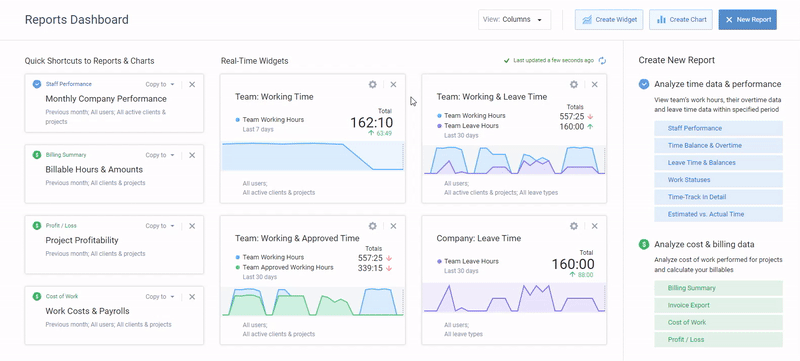
actiTIME charts and reports help to analyze productivity both on the personal and company-wide level, driving more informed and effective work management decisions.
10 Best Work Hour Trackers to Choose From
1. actiTIME
Key features:
- Multiple time tracking modes
- Reports
- Time off management
- Progress tracking
actiTIME is an intuitive work hour tracker with easy-to-use features for project and team management. With its help, you can keep a record of every minute invested in work, monitor employees’ performance progress, and analyze project results in order to boost efficiency and achieve even higher levels of productivity.
Besides that, actiTIME contains basic time off management functionality for tracking your team’s non-working days: from public and corporate holidays to sick leave and long-term vacations. And in case you need some more advanced features of this kind, you may easily integrate actiTIME with actiPLANS – an intelligent resource scheduling solution – and get a more precise and comprehensive picture of all the scheduled employee absences along with their work hours.
The best part: actiTIME has a free version for teams of up to three users. Plus, it offers a free 30-day trial in case you want to check how the software works before buying a paid subscription. Sign up for it here and see for yourself how simple and effective hour tracking can be.

We reduced payroll processing to 45 minutes per week
actiTIME is very robust, integrated well into your business process, and most importantly, helps you focus on your business instead of monkeying around with technology. actiTIME has reduced our payroll processing from 4-6 hours per week to 45 minutes per week.
2. Atto
Key features:
- Time clock
- GPS tracking
- Timesheets
- Messaging
If you need a work hour tracker with a straightforward yet powerful time clock functionality, Atto is one of the greatest options to try out. It allows users to clock in and out using a personal mobile device and provides managers with a detailed breakdown of everything their employees do at work by day and hour.
In addition to that, Atto includes GPS tracking functionality that makes it easy to see when each employee comes to their assigned work location and leaves it. This software feature will give you peace of mind if you’re worried that your field or remote employees don’t always meet their work schedule requirements.
3. Traqq
Key features:
- Automated timers
- Activity monitoring
- Payroll
- Reminders
Traqq has handy automation for a simple and streamlined work hour tracking process. Besides one-click timers that rid you of manual data entry, it contains automatic reminders that prompt when you need to take a break or come back to work after some idle time.
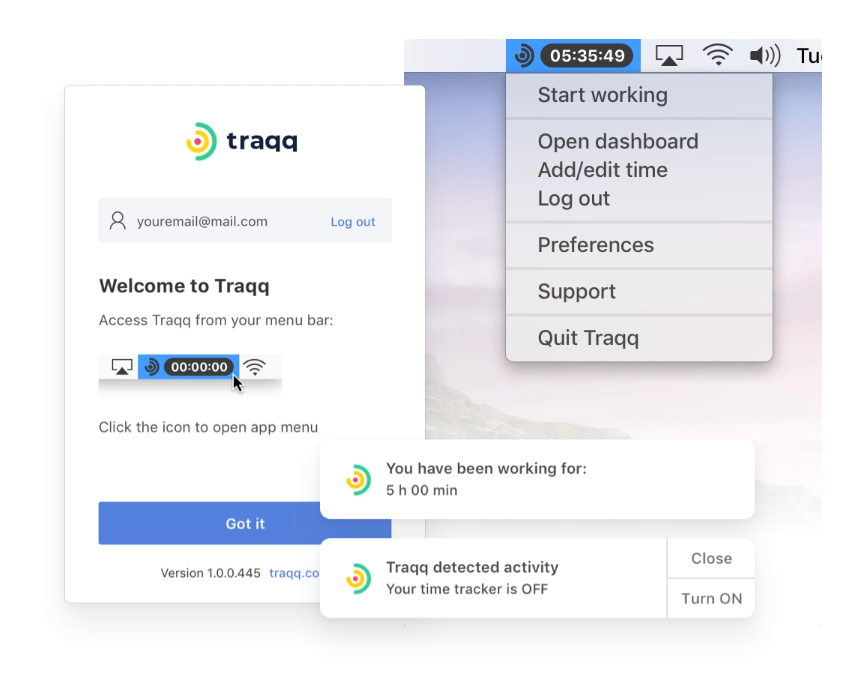
For managers, Traqq offers a set of employee monitoring features. They can help you get a precise log of every website or app your team members are visiting throughout the day, which is a good solution in case you wanna check whether they spend too much of their working time unproductively or not.
4. Timenotes
Key features:
- Work logs
- One-click timers
- Billable time tracking
- Integrations
Timenotes is a straightforward work hour tracker with several handy features for progress tracking and client billing.
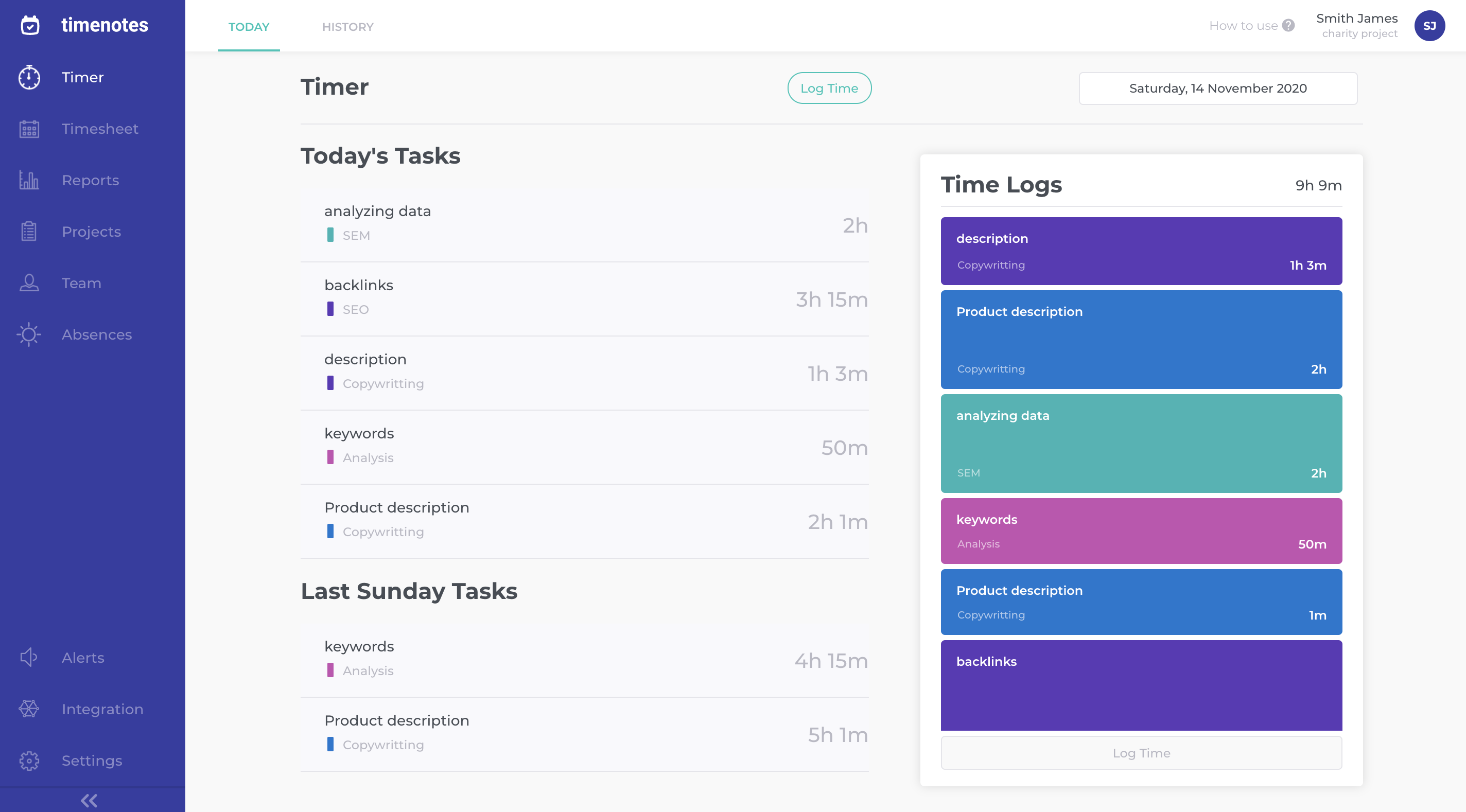
With its help, you may track employee time simply as a way to monitor team productivity and make sure your tasks and projects are delivered on schedule. Or you can set preferable billing rates and cost of work rates for different users or kinds of work and keep an accurate record of your earnings and expenses.
Moreover, it’s possible to integrate Timenotes with other software tools of choice and, this way, boost your workflow and process efficiency even more.
5. YoCoBoard
Key features:
- Time clock
- Mobile app
- Reports
- Payroll and billing
Want your work hour tracker to be as simple as can be, without any unnecessary features or a cluttered interface? Then, YoCoBoard is worth your close attention. It lets users clock in and out via their mobile devices, track time spent on project works, analyze performance results, and calculate payroll in an error-free way.
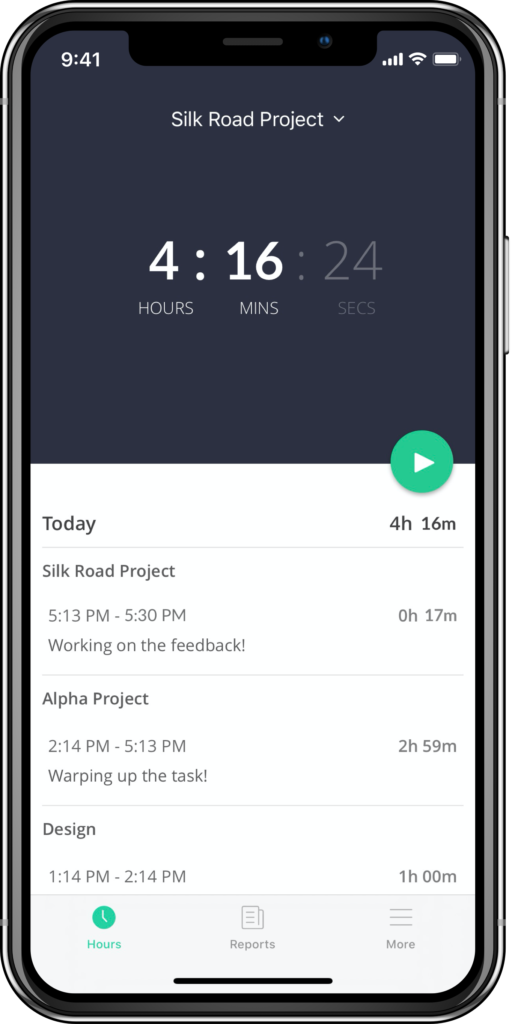
You can integrate YoCoBoard with a multitude of other tools, including Trello and Slack. Plus, it offers browser extensions for Chrome and Mozilla Firefox that allow you to track time from anywhere on the web without signing in to your account.
6. Timeular
Key features:
- Automatic time tracking
- Multiple integrations
- Mobile app
- Billable time tracking
Timeular is a novel tool designed to streamline time tracking and boost productivity both in personal and professional landscapes. Along with online software functionality, it offers an innovative gadget that allows users to track their activities by flipping a physical, eight-sided device to the corresponding side as they switch tasks.
The appeal of Timeular lies in its tactile engagement – offering a hands-on approach to time management that can seem more immediate and tangible compared to virtual trackers. However, its reliance on a physical device could be seen as a limitation, especially for mobile professionals who prefer not to carry additional gadgets.
And even if you decide to use Timeular simply as an online tool or a mobile app, its cost can be higher than many other software-only solutions, which might be a deterrent for freelancers and companies on a tight budget.
7. Jibble
Key features:
- GPS tracking
- Reports and dashboards
- Mobile app
- Facial recognition
Jibble is a cutting-edge attendance tracking tool with advanced time clock functionality. Unlike many conventional work hour trackers, it allows employees to clock in and out with just a few clicks or even with a selfie, which makes it remarkably user-friendly and reduces the risk of time theft multifold.
Jibble’s modern approach to work hour tracking provides effortless and data-rich insights into workforce patterns, which is invaluable for those seeking to optimize team operations. On top of that, Jibble can be synced with a multitude of project management and team collaboration tools like Slack and Trello. This promotes a harmonious workflow and a more convenient user experience within your favorite productivity ecosystems.
8. HiveDesk
Key features:
- Activity monitoring
- Reports
- Project tracking
- Online timecards
HiveDesk is a remote work management tool designed to help businesses track the use of time in their distributed teams. With features for geolocation tracking, online timesheet approval, random screenshot capture, project tracking, and detailed reports, HiveDesk serves as a highly versatile productivity tool.
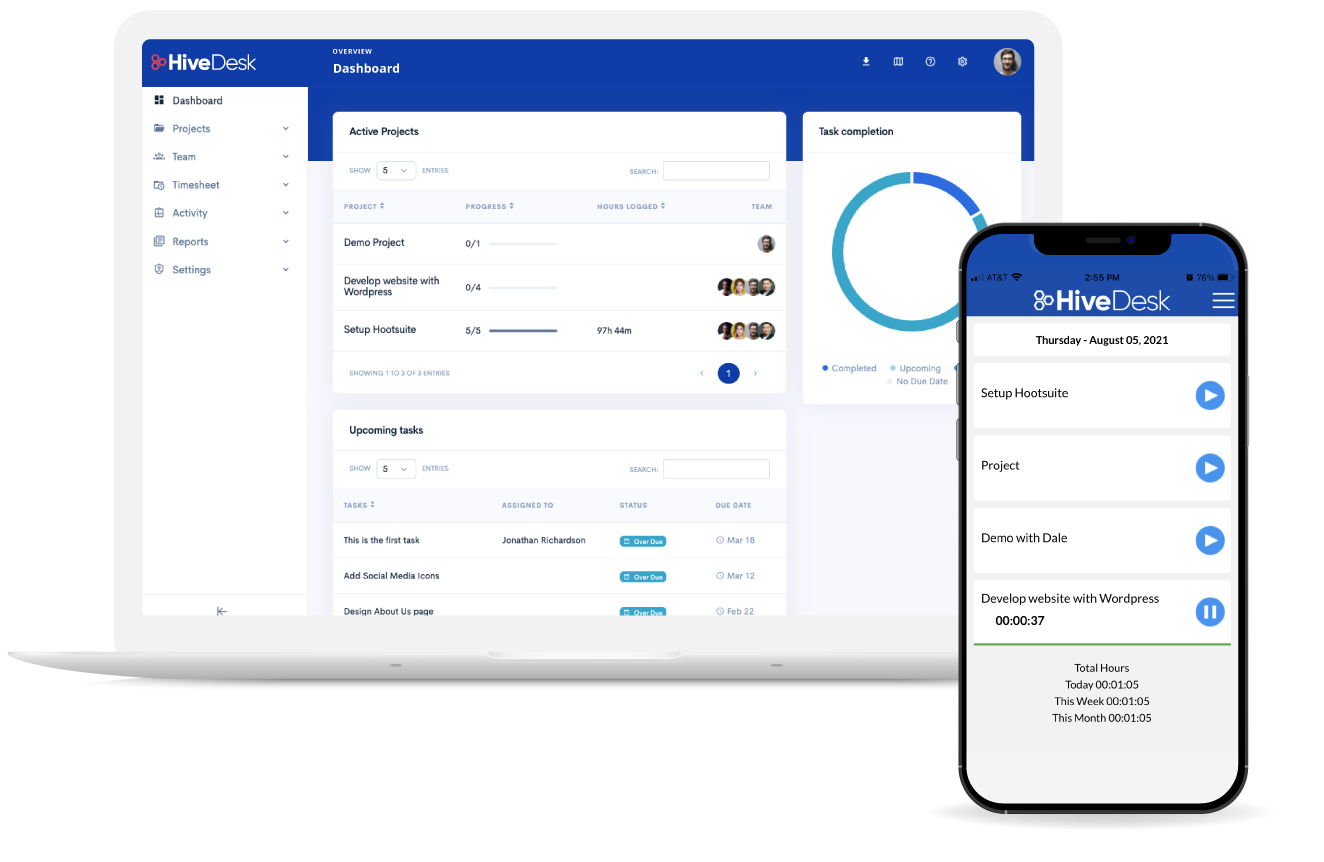
While the screenshot-taking feature helps managers keep employees at their desks, some view it as intrusive and detrimental to team morale. However, HiveDesk offers customizable settings that help to strike the right balance for each particular situation and workplace culture.
Moreover, unlike some of its competitors, HiveDesk does not include features for keystroke logging. This, to some extent, alleviates privacy concerns among employees, letting them focus on overall productivity rather than minute-by-minute activity.
9. Buddy Punch
Key features:
- GPS tracking
- Facial recognition
- Time off tracking
- Payroll integrations
Buddy Punch is another intuitive work hours tracker with time clock functionality. It allows employees to punch in and out right from their smartphones or computers, while its features for GPS tracking and overtime alerts give managers a better sense of control and simplify their lives a great deal.
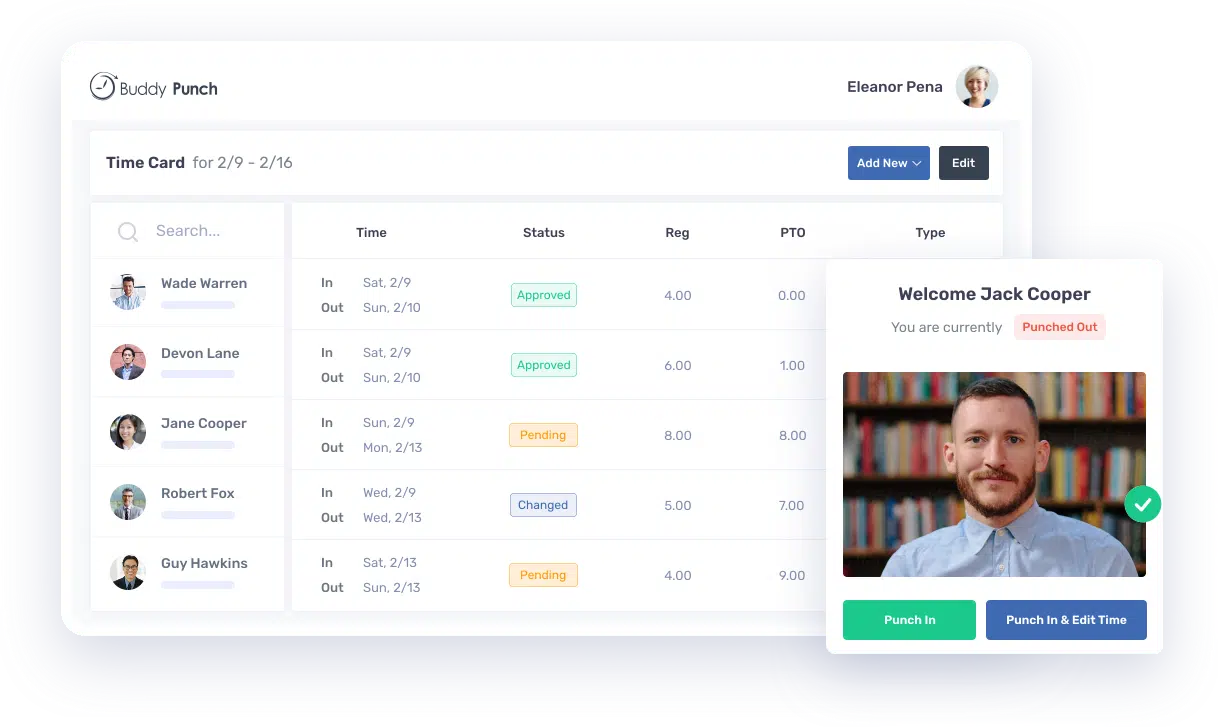
Buddy Punch’s biggest advantage is its ability to integrate with various payroll service providers, thus streamlining the wage management process significantly. Besides, it is compatible with a variety of devices, which makes it a suitable option for remote teams and those working in the field.
10. WorkStatus
Key features:
- Activity tracking
- Work scheduling
- Time off management
- Client billing
WorkStatus is a comprehensive workforce management solution that offers multiple ways to record work hours. Thanks to its wide array of features, it provides a holistic overview of employee productivity and helps to manage projects in a more effective way.
WorkStatus includes advanced automation to streamline team scheduling and resource optimization. However, this sophistication comes with a steeper learning curve that can be a disadvantage for teams looking for a simple plug-and-play solution.
Additionally, while the tool’s detailed data analytics do a great job of enhancing managerial decision-making, smaller organizations might find this feature unnecessarily complex and overwhelming, especially if their needs are somewhat basic.
Conclusion
In the end, selecting the best work hours tracker for your needs hinges on understanding the specific requirements of your team, your project, and your organizational goals. It is not a one-size-fits-all decision, so consider factors like ease of use, integration capabilities, real-time tracking features, and insightful reporting.
By carefully examining these aspects and perhaps trying out a few options, you can land a tool that not only simplifies the task of tracking hours but also contributes to overall productivity and transparency.
Remember, a work hours tracker should be your ally in efficiency, not a hurdle to overcome daily. Choose wisely and watch your team’s productivity transform.












































